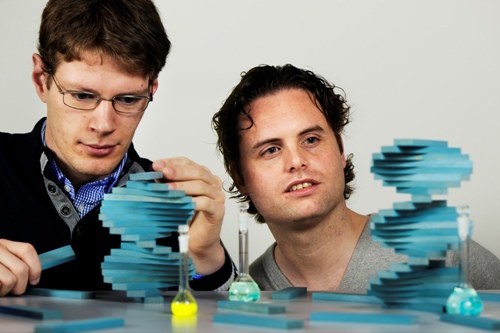A research team from the Eindhoven University of Technology (TU/e) has demonstrated that a molecular self-assembly process is capable of following various pathways, thus producing different structures.
 Researchers Peter Korevaar (left) and Tom de Greef. The blue ‘winding stairs’ represent the spiral aggregates of which the self-assembly process is described in Nature. The little flasks contain a solution of SOPV molecules. (Photo: Bart van Overbeeke)
Researchers Peter Korevaar (left) and Tom de Greef. The blue ‘winding stairs’ represent the spiral aggregates of which the self-assembly process is described in Nature. The little flasks contain a solution of SOPV molecules. (Photo: Bart van Overbeeke)
The research team has successfully monitored and manipulated the assembly process through different pathways, a major breakthrough in better understanding supramolecular polymers wherein small variations in the manner of assembly of molecular building blocks have a major impact on the properties of the end material.
Molecular building blocks form a supramolecular structure by arranging themselves through the molecular self-assembly process. Manipulating the molecular self-assembly process principles leads to the development of novel materials with innovative properties, for instance a self-repairing coating. Since the way of self-assembly of the building blocks plays a major role in the properties of the resulting materials, a slight difference in their assembly can result in materials with unique properties.
In the experiment, the research team studied a molecular building block called S-chiral oligo(p-phenylenevinylene) or SOPV utilizing pectroscopy. SOPV initially self-assembled into unstructured clusters and then into well-arranged left-handed helical structures looks like spiral staircase. Earlier, it was believed that a molecule can self-assemble only into a single end-product and the process’ intermediate steps are not significant and cannot be studied due to their rapid occurrence.
According to the TU/e research team, intermediate process steps are highly significant, as they guide to different variants. For instance, rapid occurrence of SOPV’s self-assembly process produces spiral staircase structures featuring opposite helical direction. However, when tartaric acid is added temporarily to the SOPV molecules, the assembly process is forced totally towards this alternative structure. In-depth analysis demonstrates that these two various helical forms compete for the available molecular building blocks.